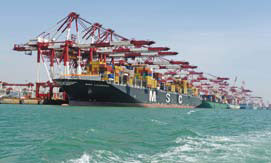Healthy waters
Updated: 2013-01-11 08:48
By Zhang Haizhou and Meng Jing (China Daily)
|
||||||||
Technology challenge
Industry experts agree that the low technology base is a major challenge for China as it strives to move up the maritime chain.
"The main reason for this is China's late entry," says Li Jingyu of the Pacific Society of China, a think tank on marine development.
Li says China still relies mainly on the big three traditional marine industries including transportation, fishing and salt for long-term growth. "It's not sustainable," he says.
China has a coastline of more than 18,000 km and 5,000 islands/islets in territorial waters with an area of more than 14,000 sq km.
In 1998, the country published its first white paper on marine economy, titled Development of China's Program. It notes that China's marine economy involves more than 20 sectors including the big three.
The sea has played an important role in China's efforts to develop an export-oriented economy over the past three decades. More than 90 percent of China's exports are transported using the sea.
According to the white paper, in the 1980s, the marine economy had annual growth rates of around 17 percent, and this subsequently rose to 20 percent during the 1990s.
However, the growth rate of traditional marine industries has been significantly slower in recent years amid global economic turmoil.
Shipping companies listed on China's A-share market, for instance, reported total losses of 7.38 billion yuan in the first nine months of last year, according to Wind Information, a leading integrated service provider of financial data in Shanghai.
China COSCO Holdings Co Ltd, the Shanghai-listed unit of the country's largest shipping group China Ocean Shipping (Group) Co, suffered the largest loss among the more than 2,000 listed companies. It posted losses of 6.4 billion yuan for the nine months till September, according to a quarterly filing.
Marine transportation grew by 7.1 percent in 2011, according to the SOA, while the fishing and salt industries grew by just 3.7 and 0.8 percent year on year. All three sectors grew slower than the previous years.
The new thrust of China's blue economy is a combination of traditional, new and emerging industries. Power generation from the sea, for instance, grew by 25 percent in 2011, while ocean biopharmaceuticals rose by 15.7 percent.
"Unlike other sectors, marine industries are more reliant on technological development," says Guan Huashi, a member of the Chinese Academy of Engineering and a professor in the Ocean University of China in Qingdao, Shandong province.
Lin Xiufen, general manager of Xiamen Blue Bay Science & Technology, a marine biomedicine maker, says that it was a proud moment for her when the Glucosamine capsules made by her company achieved purity levels in excess of 90 percent, while the world average was about 80 percent.
She says that such a feat was possible due to the close cooperation the company had with researchers from the Third Institute of Oceanography in Xiamen. "In Glucosamine technology, China is clearly the world leader, even though it lags developed countries in overall marine biology," she says.
Blue Silicon Valley
Regional governments in China, especially those on the coastline, are now taking serious steps to shore up the marine economy.
But for the moment, all the eyes are on Qingdao, a city in the coastal province of Shandong in East China. The city is setting up the Blue Silicon Valley on a vast stretch of land from Laoshan district to Jimo county in the north of the city to facilitate oceanographic research and other high-technology development as well as commercial applications for the marine sector.
|
Thirty-three projects with a combined investment of 22.2 billion yuan is under construction or in the pipeline in Qingdao's Blue Sillicon Valley. Provided to China Daily |
Nearly 33 major projects involving a combined/projected investment of around 22.2 billion yuan is either under construction or in the pipeline in the core areas of the Blue Silicon Valley at Aoshanwei town in Jimo.
"Like the Silicon Valley in the US, we want to be a paradise for entrepreneurs and innovators," says Zhang Feng, deputy head of the administration committee of the Blue Silicon Valley. "We have set up business incubators and also plan to rope in technology brokers to enhance the commercialization of research findings."
The Qingdao campus of Shandong University commenced work in July. Phase I of the Qingdao National Laboratory for Marine Science and Technology was completed last year, and is now looking to attract renowned oceanographers from around the globe.
The area's National Deep-Sea Base made history last year when its Jiaolong deep-sea submersible broke the 7,000-meter-mark on July 16.
The national deep-sea base program is the fifth of its kind in the world after the US, Russia, France and Japan.
Other programs that will be built in the area include the National Inspection Center for Marine Equipment, Qingdao Institute of Marine Geology and the R&D Center of Beidou Navigation.

 Li Na on Time cover, makes influential 100 list
Li Na on Time cover, makes influential 100 list
 FBI releases photos of 2 Boston bombings suspects
FBI releases photos of 2 Boston bombings suspects
 World's wackiest hairstyles
World's wackiest hairstyles
 Sandstorms strike Northwest China
Sandstorms strike Northwest China
 Never-seen photos of Madonna on display
Never-seen photos of Madonna on display
 H7N9 outbreak linked to waterfowl migration
H7N9 outbreak linked to waterfowl migration
 Dozens feared dead in Texas plant blast
Dozens feared dead in Texas plant blast
 Venezuelan court rules out manual votes counting
Venezuelan court rules out manual votes counting
Most Viewed
Editor's Picks

|

|

|

|

|

|
Today's Top News
Boston bombing suspect reported cornered on boat
7.0-magnitude quake hits Sichuan
Cross-talk artist helps to spread the word
'Green' awareness levels drop in Beijing
Palace Museum spruces up
First couple on Time's list of most influential
H7N9 flu transmission studied
Trading channels 'need to broaden'
US Weekly

|

|








